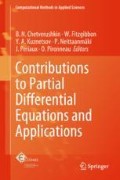Abstract
This contribution is based on a theorem of Kato which relates for time dependent problems the appearance of turbulence with the anomalous energy dissipation, giving for the Cauchy problem an avatar of a basic idea of the statistical theory of turbulence. Some variant of this theorem are given and then it is shown how this point of view is in full agreement with several issues of fluid mechanic ranging from Prandtl’s problem to Kutta-Jukowsky’s equations.
Access this chapter
Tax calculation will be finalised at checkout
Purchases are for personal use only
References
Asano A (1991) Zero-viscosity limit of the incompressible Navier-Stokes equations. In: Fourth workshop on mathematical aspects of fluid and plasma dynamics. Kyoto
Bardos C, Nguyen TN (2016) Remarks on the inviscid limit for the compressible flows. In: Radulescu D, Sequeira A, Solonnikov VA (eds) Recent advances in partial differential equations and applications, volume 666 of Contemp. Math. Providence, RI. AMS, pp 55–67
Bardos C, Titi ES (2013) Mathematics and turbulence: where do we stand? J Turbul 14(3):42–76
Bardos C, Titi ES, Wiedemann E (2012) The vanishing viscosity as a selection principle for the Euler equations: the case of 3D shear flow. CR Math Acad Sci Paris 350(15–16):757–760
Bardos K Jr, Sekelikhidi L, Videmann E (2014) On the absence of uniqueness for the Euler equations: the effect of the boundary. Uspekhi Mat Nauk 69(2(416)):3–22. Translation in Russian Math Surv 69(2):189–207
Buckmaster T, De Lellis C, Székelyhidi L Jr (2016) Dissipative Euler flows with Onsager-critical spatial regularity
Cheskidov A, Constantin P, Friedlander S, Shvydkoy R (2008) Energy conservation and Onsager’s conjecture for the Euler equations. Nonlinearity 21(6):1233–1252
Constantin P, Weinan E, Titi ES (1994) Onsager’s conjecture on the energy conservation for solutions of Euler’s equation. Comm Math Phys 165(1):207–209
Constantin P, Elgindi T, Ignatova M, Vicol V (2017) Remarks on the inviscid limit for the Navier-Stokes equations for uniformly bounded velocity fields. SIAM J Math Anal 49(3):1932–1946
Constantin P, Kukavica I, Vicol V (2015) On the inviscid limit of the Navier-Stokes equations. Proc Amer Math Soc 143(7):3075–3090
De Lellis C, Székelyhidi L Jr (2009) The Euler equations as a differential inclusion. Ann Math (2) 170(3):1417–1436
Frisch U (1995) Turbulence. Cambridge University Press, Cambridge
Gerard-Varet D, Masmoudi N (2015) Well-posedness for the Prandtl system without analyticity or monotonicity. Ann Sci Éc Norm Supér (4) 48(6):1273–1325, 2015
Kato T (1984) Remarks on zero viscosity limit for nonstationary Navier-Stokes flows with boundary. In: Seminar on nonlinear partial differential equations (Berkeley, CA, 1983), volume 2 of Math Sci Res Inst Publ. Springer, New York
Landau LD, Lifshitz EM (1959) Fluid mechanics. Pergamon Press, London
Lebeau G (2002) Régularité du problème de Kelvin-Helmholtz pour l’équation d’Euler 2d. ESAIM Control Optim Calc Var 8:801–825
Marchioro C, Pulvirenti M (1994) Mathematical theory of incompressible nonviscous fluids, vol 96 of Applied Mathematical Sciences. Springer, New York
Mohammadi B, Pironneau O (1994) Analysis of the \(k\)-epsilon turbulence model. Wiley, Chichester
Onsager L (1949) Statistical hydrodynamics. Nuovo Cimento (9) 6(2):279–287
Periaux J (1975) Three dimensional analysis of compressible potential flows with the finite element method. Int J Numer Methods Eng 9(4):775–831
Prandtl L (1904) Uber flüssigkeits-bewegung bei sehr kleiner reibung. Actes du 3ème Congrès international des Mathématiciens (Heidelberg). Teubner, Leipzig, pp 484–491
Sammartino M, Caflisch RE (1998) Zero viscosity limit for analytic solutions, of the Navier-Stokes equation on a half-space. I. Existence for Euler and Prandtl equations. Comm Math Phys 192(2):433–461
Scheffer V (1993) An inviscid flow with compact support in space-time. J Geom Anal 3(4):343–401
Shnirelman A (1997) On the nonuniqueness of weak solution of the Euler equation. Comm Pure Appl Math 50(12):1261–1286
Shvydkoy R Private communication
Stewartson K (1974) Multistructured boundary layers on flat plates and related bodies. Adv Appl Mech 14:145–239
Wu S (2002) Recent progress in mathematical analysis of vortex sheets. In: Proceedings of the international congress of mathematicians, vol III. Beijing, Higher Ed. Press, pp 233–242
Acknowledgements
Warm thanks to the organizers of the International Workshop on Applied and Computational Mathematics, Houston, February 2016 for their invitation to give a talk and to propose an article in the present volume, giving me an opportunity to congratulate Olivier Pironneau for his 70th birthday and to express my gratitude for his everlasting friendship and support.
Author information
Authors and Affiliations
Corresponding author
Editor information
Editors and Affiliations
Rights and permissions
Copyright information
© 2019 Springer International Publishing AG, part of Springer Nature
About this chapter
Cite this chapter
Bardos, C. (2019). Zero Viscosity Boundary Effect Limit and Turbulence. In: Chetverushkin, B., Fitzgibbon, W., Kuznetsov, Y., Neittaanmäki, P., Periaux, J., Pironneau, O. (eds) Contributions to Partial Differential Equations and Applications. Computational Methods in Applied Sciences, vol 47. Springer, Cham. https://doi.org/10.1007/978-3-319-78325-3_7
Download citation
DOI: https://doi.org/10.1007/978-3-319-78325-3_7
Published:
Publisher Name: Springer, Cham
Print ISBN: 978-3-319-78324-6
Online ISBN: 978-3-319-78325-3
eBook Packages: EngineeringEngineering (R0)

